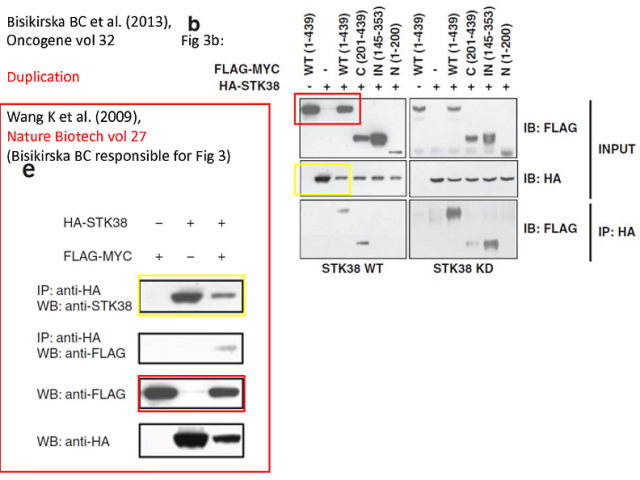You could be forgiven for thinking there’s a bit of a crisis going on in biomedical science these days. Tenured academic positions are few and far between—and are often dependent upon the researcher’s success in obtaining scarce funding. The pressure to succeed, measured by publications, is sometimes blamed for leading less-scrupulous scientists to break the rules. A new paper by Morton Oskvold, a Norwegian scientist, will fan those flames, as it makes the bold claim that 25 percent of cancer biology papers contain duplicated data. Is something rotten in our research labs?
There has been a real uptick in scientific misconduct in recent years, but it’s not going unchallenged. Post-publication peer review, where papers are critiqued publicly on the Internet by other scientists, is putting the literature to the test. And journals are taking a tougher line with authors to ensure that they include all the relevant details, not just the ones that make them look good.
Some of this comes in response to high-profile publications like one from researchers at the biotech company Amgen, who tried to reproduce the findings of 53 “landmark” preclinical cancer research papers but were only able to do so for six of them.
Oskvold’s paper, published in Science and Engineering Ethics, looked at cancer biology papers published in three journals (International Journal of Oncology, Oncogene, and Cancer Cell) during 2013. He selected 40 papers from each journal at random and then systematically examined the data in each, looking for images (or elements in images) that appeared more than once. In papers where these elements were found, Oskvold then dug deeper, also looking at other publications from the same authors to see if there was evidence of reused data.
The images Oskvold focused on are photographs of Western blots (where proteins are separated by weight and labeled with antibodies) and microscope images (again, often labeled with fluorescent antibodies).
The results are rather startling—a quarter of the papers showed identical images in two or more figures, a finding that was consistent across all three journals. However, once one digs a little deeper into the results, some of the findings that Oskvold calls problematic turn out to be a bit less clear-cut. That’s because the data duplications fall into one of two categories. Just over half of the papers with duplications pass off the same image as two completely different experiments. That is clearly outside the bounds of acceptable behavior for scientists, and bravo to Oskvold for calling them to account.

But in the other cases, the duplications are data from the same experimental conditions. For example, using a subset of a Western blot in one figure, then another subset (including the same control) in a second figure. Oskvold calls the publication into doubt because it raises uncertainty about whether or not sufficient experiments were actually performed—it’s not enough to do it once, shout “eureka!” and send off the manuscript. But many other scientists take issue with this hardline view, something evident from a lengthy discussion of Oskvold’s findings at PubPeer (Oskvold is Peer 1).
There are legitimate reasons for reusing the same data in more than one figure. As mentioned, budgets are tight, reagents aren’t cheap, and it’s often prudent to run a Western blot with eight or ten (or more) samples at once. However, dumping all this data out at once might not be the most effective way of communicating a researcher’s results; using subsets of an experiment to communicate specific points may be more effective. In fact, there’s evidence of exactly this kind of duplication in one of Oskvold’s own publications.
Oskvold contacted each of the journals about his findings, as well as the authors for the 29 papers where he found duplication (he also started PubPeer threads for each one). Only one of the authors responded (accepting responsibility for mixing up the images), along with a second unverified author (who claimed the journal made the error during page layout). He didn’t hear back from any of the three journal editorial boards.
While we don’t think that the initial claim—a quarter of cancer research is fake—is accurate, the fact that it’s closer to one in eight should still be troubling. A lot of responsibility rests with the authors who write these papers, as well as the reviewers and journal editors who accept them for publication. With bandwidth and storage as cheap as they are now, there’s no good reason why one shouldn’t be asked to submit the raw data for each experiment when submitting a paper.
Sadly, the pressure to puff up one’s findings probably isn’t going away any time soon. So, unless there’s an organized strengthening of standards, problems like these probably won’t go away either.
Science and Engineering Ethics, 2015. DOI: 10.1007/s11948-015-9668-7 (About DOIs).
Source: Ars Technica

